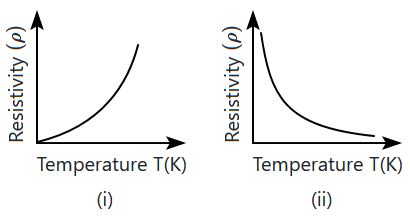The plot of current \(I~\text{(A)}\) flowing through a metallic conductor versus the applied voltage \(V~\text{(volt)}\) across the ends of a conductor is:
| 1. |  |
2. |  |
| 3. |  |
4. |  |
Which of the following \((\text{I-V})\) graphs represents ohmic conductors?
| 1. |  |
2. |  |
| 3. |  |
4. |  |
Figure (i) and figure (ii) both are showing the variation of resistivity \((\rho)\) with temperature (T) for some materials. Identify the type of these materials.
| 1. | conductor and semiconductor |
| 2. | conductor and Insulator |
| 3. | insulator and semiconductor |
| 4. | both are conductors |
The dependence of resistivity \((\rho)\) on the temperature \((T)\) of a semiconductor is, roughly, represented by:
| 1. |  |
2. |  |
| 3. |  |
4. |  |

1.  |
2.  |
3.  |
4.  |
Three resistors are connected to a \(20\) V battery with a constant supply. One of the resistors is a variable resistor. The resistance of the variable resistor is gradually increased from zero to \(5\) \(\Omega.\)
Which graph shows how the current from the battery varies with the resistance \((R)\) of the variable resistor?
| 1. |  |
2. |  |
| 3. |  |
4. |  |
Which of the following graph represents the variation of resistivity () with temperature (\(T\)) for copper?
| 1. |  |
2. |  |
| 3. |  |
4. |  |
| Assertion (A): | Resistance of a conducting metallic wire depends on the voltage applied across it and current passing through it. |
| Reason (R): | Ohm's law is also valid for semiconductors. |
In the light of the above statements choose the correct answer from the options given below:
| 1. | Both (A) and (R) are true and (R) is the correct explanation of (A). |
| 2. | Both (A) and (R) are true but (R) is not the correct explanation of (A). |
| 3. | (A) is true but (R) is false. |
| 4. | Both (A) and (R) are false. |

1. \(T_{1}=T_{2}\)
2. \(T_{2}>T_{1}\)
3. \(T_{1}>T_{2}\)
4. nothing can be said




